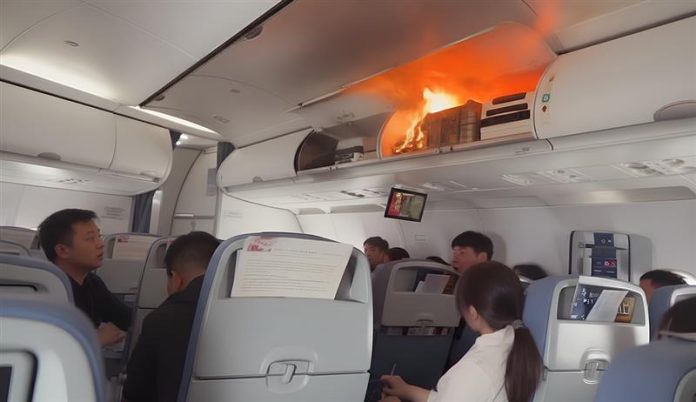On 18 October 2025, Air China flight CA139, en route from Hangzhou Xiaoshan International Airport in eastern China to Incheon International Airport, South Korea, was forced to make an emergency landing at Shanghai Pudong International Airport after a lithium-battery device in a passenger’s carry-on bag ignited in mid-air.
According to the airline, the Airbus A321 operating the flight departed Hangzhou at approximately 09:47 local time and was scheduled to arrive in Incheon at 12:20. Roughly 40 minutes into the flight, a fire broke out in an overhead compartment when a lithium-ion battery in a passenger’s bag “spontaneously ignited”.
Cabin video footage circulating online shows visible flames and thick smoke pouring from the overhead bin as flight attendants move swiftly to extinguish the fire while passengers watch in alarm.
In its official statement, Air China said:
“On October 18, on flight CA139 from Hangzhou to Incheon, a lithium battery in a passenger’s carry-on luggage stored in the overhead compartment spontaneously ignited. The crew immediately handled the situation according to procedures, and no one was injured. To ensure flight safety, the aircraft made an unscheduled landing at Shanghai Pudong International Airport.”
The diversion to Shanghai occurred without any reported injuries or structural damage to the aircraft. Passengers were later accommodated on a replacement aircraft to continue their journey.
This incident underscores growing concerns over the carriage of lithium-ion batteries on board commercial flights. Lithium-ion batteries, commonly found in smartphones, laptops, power banks and other devices, are subject to risks of overheating, short-circuiting or “thermal runaway”, which can trigger sudden combustion without warning.
Regulatory agencies and aviation authorities have tightened rules on batteries and portable chargers in recent months. In China, the Civil Aviation Administration of China (CAAC) banned the carriage of power banks without proper certification on domestic flights as of 28 June 2025.
For operators such as Battery News, the event is a stark reminder of the latent hazards posed by lithium battery devices and the importance of clear passenger communication, proper storage procedures, and vigilant crew readiness. When a battery fire occurred in an overhead storage bin at approximately 33,000 ft, the cabin crew swiftly retrieved fire extinguishers, opened and doused the affected bin, and asked passengers to remain seated while smoke spread briefly through the aisle.
A Warning Ignored
Looking ahead, the industry may expect increased scrutiny and further regulatory action. Airlines and regulators might review both packaging and stowage rules for lithium-ion batteries: stricter labelling requirements, bans on unverified power banks, and more detailed guidance on carrying such devices in overhead compartments. The CA139 incident adds to a growing list of battery-related in-flight emergencies across Asia this year.
As travellers, it is essential to ensure any carried lithium-ion devices comply with airline policies, remain in the approved carry-on locations, and are not stored in locations where fire-response access is delayed. The safe handling of such high-energy devices is increasingly a vital component of aviation safety in 2025 and beyond.
Read the Latest Battery News Shaping the Global Power Market
References


